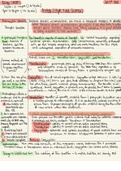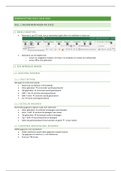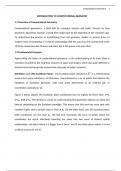Notes on Geographies of Youth in changing societies
Lecture 1
Youth use public space and transform it into something else. Developing their identities, and
claiming the public space, the young people can transform it into something more good
looking. Young people’s landscapes of security and insecurity. Future changes and
transformations in social and cultural relations are often first witnessed amongst younger
people.
Many securities and insecurities are not addressed from a young people’s perspective. Think
of the ontological security, home security, global security and online security. Many complex
issues such as globalization and migration are not mentioned for the youth. When the youth
can think about those issues and have a say; they have a feeling in control and knowing what
to expect, feeling in place, feeling you belong. All above mentioned threats can cause a
feeling of insecurity among the youth. Their perspectives can be implemented in politics to
do actual change.
Article on Hopkins (2019)
‘Youth’ is often uncritically interchanged with ‘the future’ in public debates. But often not as
agents or individuals in their own right. In fact, young people are frequently misunderstood,
misrepresented and stigmatized. Politicians can represent the young people, but often they
take away the agency of the young. They don’t have a voice themselves. Young people can be
seen a becoming adults, but you can also see them as becoming ‘the other’ than the adults
we know nowadays.
Young people are not simply beings or becomings, they are more significantly doings that
have the potential to become and do something different, something yet unimaginable. The
youth has not only negative stereotypes attached to it, but they are also playful, generative
and creative. They can think outside of the system.
1. Identities and belongings
2. Inequalities
3. Public space
The main concepts of this course are geographies, youth, changing societies, place, space,
scale and sites. Youth is a socio-spatial construct in relation to identities, inequalities and
public spaces. Young people have the capacity to change and create (changing societies).
Geographies of youth in changing societies -> in the united nations the children are defined
as age 0-17 and youth is defined as persons aged 15-24. Based on the ‘western’ perspective,
but varies across countries and organizations. Initiation rituals or rites-of-passage more
important in other contexts – meanings vary across time and space.
,You have look at age through 3 different approaches.
- Chronological age – the amount of years. Certain activities can (legally) happen when
you have reached a certain age.
- Psychological age – the age that your body communicates to others. Associations with
health for example. You can look older than your chronological age.
- Social age –
Ageism is the result of the ways in which assumptions are made about people having other
things in common alongside their chronological age. This is an constantly shifting
phenomenon.
Youth can be seen as a transition. Drawing on socialization theories, youth has therefore
been understood as a period of transition between childhood and adulthood, marked
predominantly by increasing responsibility and independence. Children and young people
are temporally set apart from the adult world and that childhood is a time of innocence and
freedom from the responsibilities of adulthood. We can view the youth as a bad or a good.
, Being young is often described as something that is not. Young are the opposite of adults,
but this is not always the case.
Generationing is based on the premise that children and young people’s lives are situated in
generational relations operating at various scales and that their agency must be understood
as situated generationally. Today’s young people differ from yesterday’s. every age group
belongs to a different generation.
Being young is an identity, but your identity is not only your youth. ‘Youth’ is a social
construct, i.e. a category or group that is made ‘real’ by convention or collective agreement.
In fact, ‘youth’ is a plural and heterogeneous category and varies across space and time due
to different societal meanings. So, in thinking about [youth’] identity and the ways it is given
meaning through social relations, we also need to think about the processes that create
particular identities and make them matter in different ways. There is inequality and power
involved. Who is allowed to be young? Poverty can restrict the young people.
So the youth are confronted with exploitation, marginalization, powerlessness, cultural
imperialism and violence.
Before 1998, there was no attention to the geographies of youth and their studies. But the
Cool Places tried to explain that places and youth do matter. How do they use and change
space? It was a response to focus on youth subcultures and criminalization. Places used,
inhabited and associated with young people matter! Rather than having fixed boundaries,
place is now recognized as having open and permeable boundaries, shaped by complex webs
of local, national and global influences and different social and cultural flows and process.
Geographies of Youth highlight that children and young people imagine places in qualitatively
different ways compared to adults. Young people tap into influences and references by
‘leaping’ geographical scales such as body, home, neighborhood, nation, global. Local youth
identities and cultures are a product of interacting social relations. There is a complex but
progressive sense of place. Some places can have multiple functions, such as urban/rural,
institutions, migration and mobility and university.
Lecture 1
Youth use public space and transform it into something else. Developing their identities, and
claiming the public space, the young people can transform it into something more good
looking. Young people’s landscapes of security and insecurity. Future changes and
transformations in social and cultural relations are often first witnessed amongst younger
people.
Many securities and insecurities are not addressed from a young people’s perspective. Think
of the ontological security, home security, global security and online security. Many complex
issues such as globalization and migration are not mentioned for the youth. When the youth
can think about those issues and have a say; they have a feeling in control and knowing what
to expect, feeling in place, feeling you belong. All above mentioned threats can cause a
feeling of insecurity among the youth. Their perspectives can be implemented in politics to
do actual change.
Article on Hopkins (2019)
‘Youth’ is often uncritically interchanged with ‘the future’ in public debates. But often not as
agents or individuals in their own right. In fact, young people are frequently misunderstood,
misrepresented and stigmatized. Politicians can represent the young people, but often they
take away the agency of the young. They don’t have a voice themselves. Young people can be
seen a becoming adults, but you can also see them as becoming ‘the other’ than the adults
we know nowadays.
Young people are not simply beings or becomings, they are more significantly doings that
have the potential to become and do something different, something yet unimaginable. The
youth has not only negative stereotypes attached to it, but they are also playful, generative
and creative. They can think outside of the system.
1. Identities and belongings
2. Inequalities
3. Public space
The main concepts of this course are geographies, youth, changing societies, place, space,
scale and sites. Youth is a socio-spatial construct in relation to identities, inequalities and
public spaces. Young people have the capacity to change and create (changing societies).
Geographies of youth in changing societies -> in the united nations the children are defined
as age 0-17 and youth is defined as persons aged 15-24. Based on the ‘western’ perspective,
but varies across countries and organizations. Initiation rituals or rites-of-passage more
important in other contexts – meanings vary across time and space.
,You have look at age through 3 different approaches.
- Chronological age – the amount of years. Certain activities can (legally) happen when
you have reached a certain age.
- Psychological age – the age that your body communicates to others. Associations with
health for example. You can look older than your chronological age.
- Social age –
Ageism is the result of the ways in which assumptions are made about people having other
things in common alongside their chronological age. This is an constantly shifting
phenomenon.
Youth can be seen as a transition. Drawing on socialization theories, youth has therefore
been understood as a period of transition between childhood and adulthood, marked
predominantly by increasing responsibility and independence. Children and young people
are temporally set apart from the adult world and that childhood is a time of innocence and
freedom from the responsibilities of adulthood. We can view the youth as a bad or a good.
, Being young is often described as something that is not. Young are the opposite of adults,
but this is not always the case.
Generationing is based on the premise that children and young people’s lives are situated in
generational relations operating at various scales and that their agency must be understood
as situated generationally. Today’s young people differ from yesterday’s. every age group
belongs to a different generation.
Being young is an identity, but your identity is not only your youth. ‘Youth’ is a social
construct, i.e. a category or group that is made ‘real’ by convention or collective agreement.
In fact, ‘youth’ is a plural and heterogeneous category and varies across space and time due
to different societal meanings. So, in thinking about [youth’] identity and the ways it is given
meaning through social relations, we also need to think about the processes that create
particular identities and make them matter in different ways. There is inequality and power
involved. Who is allowed to be young? Poverty can restrict the young people.
So the youth are confronted with exploitation, marginalization, powerlessness, cultural
imperialism and violence.
Before 1998, there was no attention to the geographies of youth and their studies. But the
Cool Places tried to explain that places and youth do matter. How do they use and change
space? It was a response to focus on youth subcultures and criminalization. Places used,
inhabited and associated with young people matter! Rather than having fixed boundaries,
place is now recognized as having open and permeable boundaries, shaped by complex webs
of local, national and global influences and different social and cultural flows and process.
Geographies of Youth highlight that children and young people imagine places in qualitatively
different ways compared to adults. Young people tap into influences and references by
‘leaping’ geographical scales such as body, home, neighborhood, nation, global. Local youth
identities and cultures are a product of interacting social relations. There is a complex but
progressive sense of place. Some places can have multiple functions, such as urban/rural,
institutions, migration and mobility and university.







